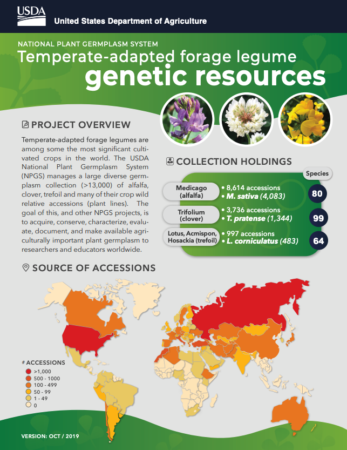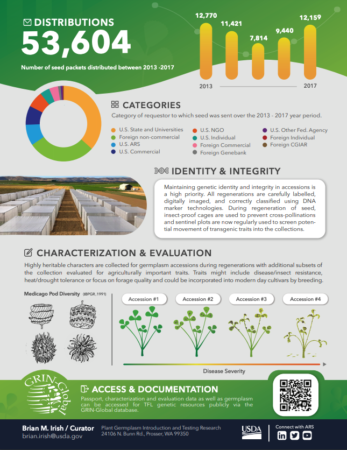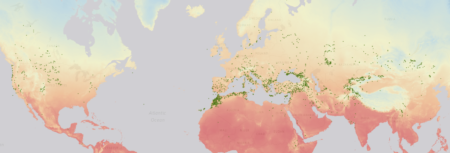- Global modeling of nature’s contributions to people. Declining where the need is greatest. And that’s not even taking CWR into account.
- Farmer’s Varieties in India – Factors affecting their preferential prevalence and the current status of their legal protection. Open-pollinated crops are missing out.
- The bracteatus pineapple genome and domestication of clonally propagated crops. Domestication and early improvement as the result of a single clonal propagation event.
- Transposons played a major role in the diversification between the closely related almond and peach genomes: Results from the almond genome sequence. Including the sweet kernel phenotype.
- Genome-wide association mapping of date palm fruit traits. Fruit color and sugar composition changed in parallel.
- Genetic diversity and population structure of the Mediterranean sesame core collection with use of genome-wide SNPs developed by double digest RAD-Seq. Three genetic groups, but not geographically based.
- Ongoing accumulation of plant diversity through habitat connectivity in an 18-year experiment. You need those corridors.
- Meta‐analysis of the differential effects of habitat fragmentation and degradation on plant genetic diversity. You really do.
- In search of alternative proteins: unlocking the potential of underutilized tropical legumes. Beyond soybeans. I always liked Bambara groundnut.
- A scalable scheme to implement data-driven agriculture for small-scale farmers. Fancy maths put to some good use in Colombia. But what if it tells you to grow more coca?
- The evolution of crops that do not need us anymore. They’re called weeds.
Nibbles: How-to trifecta, Indigenous maps, ITPGRFA, SeedLinked, Tequila
- The Center for Plant Conservation has Best Plant Conservation Practices to Support Species Survival in the Wild. With online forum goodness.
- A little bit down-market, there’s What Are Seed Banks: A Complete Guide.
- How Do We Preserve the Vanishing Foods of the Earth? Good question, and nice article, but there’s surely more to the answer than what it says.
- Like indigenous people.
- And the Plant Treaty. Here’s two provocative briefing papers on that from the African Centre for Biodiversity in the run-up to the Governing Body meeting in November.
- Oh, and breeding. Even crowd-sourced breeding.
- Let the tequila industry show you what to do, in fact.
Brainfood: Neolithic dairy, Wheat phenology, Carob origin, Malawi diets, Maize evolution, Bean domestication, Human evolution & diets, Chickpea pre-breeding, Food trade, Scaling up conservation, Apple leaves, Winged bean nutrition, White clover pedigrees, Bushmeat
- Milk of ruminants in ceramic baby bottles from prehistoric child graves. Neolithic sippy cups. Cute.
- Heat and Drought Stress Advanced Global Wheat Harvest Timing from 1981–2014. 2.5 days per decade.
- A strong east–west Mediterranean divergence supports a new phylogeographic history of the carob tree (Ceratonia siliqua, Leguminosae) and multiple domestications from native populations. No evidence of an eastern refugium.
- Value chains to improve diets: Diagnostics to support intervention design in Malawi. You can modify existing social protection interventions to optimize diets (including increasing diet diversity) by enhancing public- and private-sector linkages.
- Contemporary evolution of maize landraces and their wild relatives influenced by gene flow with modern maize varieties. Landrace genetic diversity actually increased due to introgression from modern varieties.
- Ancient genomes reveal early Andean farmers selected common beans while preserving diversity. Because they applied weak selection. Can breeders learn from this? Also, is it similar for maize?
- Reconstruction of nine thousand years of agriculture-based diet and impact on human genetic diversity in Asia. Changes in diet through domestication and processing have left signatures on the human genome.
- Transgressive segregations for agronomic improvement using interspecific crosses between C. arietinum L. x C. reticulatum Ladiz. and C. arietinum L. x C. echinospermum Davis species. For things like pod number, earliness and tolerance to cold.
- Linking global crop and livestock consumption to local production hotspots. China is the largest consumer of primary crops, and the third largest consumer of livestock. The Corn Belt, cerrado, Europe and E. China feeds it, and the world.
- How conservation initiatives go to scale. With great difficulty.
- Morphometrics Reveals Complex and Heritable Apple Leaf Shapes. It’s mainly about aspect ratio.
- Nutrient and Antinutrient Composition of Winged Bean (Psophocarpus tetragonolobus (L.) DC.) Seeds and Tubers. The best, and worst, among 50 accessions. Spoiler alert: it depends on the nutrient, and on whether you prefer the seeds or tubers.
- Identification of Founding Accessions and Patterns of Relatedness and Inbreeding Derived from Historical Pedigree Data in a White Clover Germplasm Collection in New Zealand. 15,000 accessions trace to about 175 founders.
- Poverty not taste drives the consumption of protected species in Madagascar. Let them eat domestic livestock meat.
Nibbles: Diversification, Watermelon lecture, Global productivity gaps, Kenyan CWR, Indian rice diversity, Native American seeds, Cool newsletters
- Value chains for baskets of products to diversify production and consumption.
- Video lecture on watermelon domestication.
- “…global agricultural productivity needs to increase at an average annual rate of 1.73 percent to sustainably produce food, feed, fiber, and bioenergy for 10 billion people in 2050.
- Maybe crop wild relatives can help? Kenyan media thinks so. This is the project in question, though you wouldn’t know it from the article.
- Somewhat one-sided account of ex situ rice conservation in India. People are looking into some of the claims…
- The Native American Seeds Protection Act of 2019 explained. Fingers crossed.
- Latest newsletters: the European PGRFA network & Genesys.
Temperate forages at the NPGS
We just got hold of a very neat infographic summarizing the work of the USDA’s National Plant Germplasm System on the Management of Temperate-adapted Forage Legume Genetic Resources and Associated Information.
If you were to scan that QR code, you’d get here, and be able to select and order material from the USDA’s GRIN-Global site.
Here’s the distribution of over 6000 USDA-held accessions of Medicago, Trifolium and Lotus with geographical coordinates according to Genesys.
The colours show annual mean temperature.


